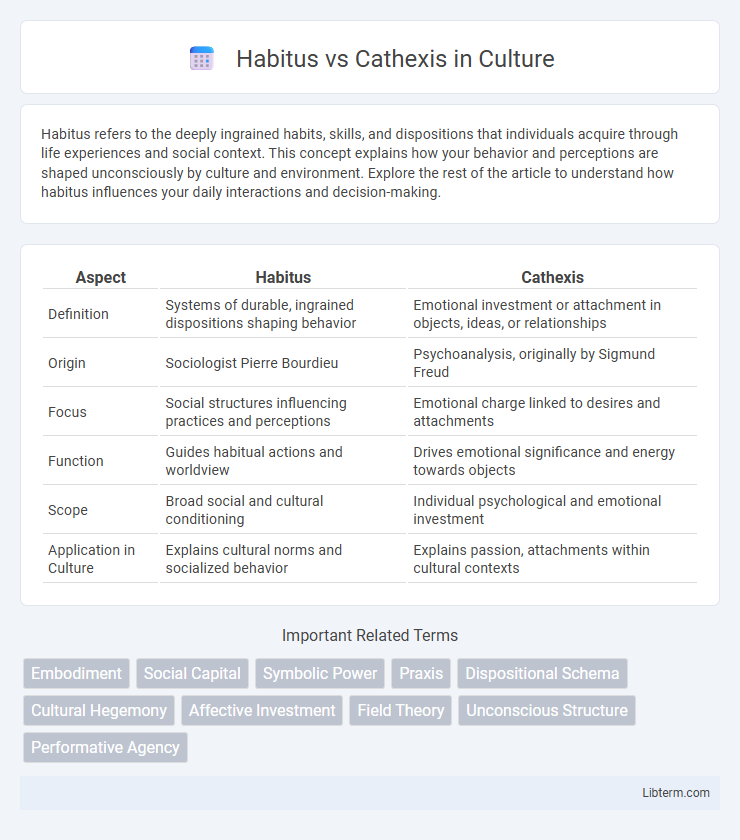Habitus refers to the deeply ingrained habits, skills, and dispositions that individuals acquire through life experiences and social context. This concept explains how your behavior and perceptions are shaped unconsciously by culture and environment. Explore the rest of the article to understand how habitus influences your daily interactions and decision-making.
Table of Comparison
| Aspect | Habitus | Cathexis |
|---|---|---|
| Definition | Systems of durable, ingrained dispositions shaping behavior | Emotional investment or attachment in objects, ideas, or relationships |
| Origin | Sociologist Pierre Bourdieu | Psychoanalysis, originally by Sigmund Freud |
| Focus | Social structures influencing practices and perceptions | Emotional charge linked to desires and attachments |
| Function | Guides habitual actions and worldview | Drives emotional significance and energy towards objects |
| Scope | Broad social and cultural conditioning | Individual psychological and emotional investment |
| Application in Culture | Explains cultural norms and socialized behavior | Explains passion, attachments within cultural contexts |
Defining Habitus: Origins and Key Concepts
Habitus, a concept developed by sociologist Pierre Bourdieu, refers to the deeply ingrained habits, skills, and dispositions that individuals acquire through their life experiences and social context. It shapes perceptions, thoughts, and actions unconsciously, influencing how people navigate social structures. Key concepts include the internalization of external social conditions, durability over time, and the role of habitus in reproducing social practices and power relations.
Understanding Cathexis: Meaning and Psychological Roots
Cathexis refers to the psychological investment of emotional energy in a person, object, or idea, originating from psychoanalytic theory. It involves the attachment of libido to mental representations, shaping desires, motivations, and behaviors through unconscious processes. Understanding cathexis reveals how emotional charges influence internal drives and external actions, differentiating it from habitus, which relates to ingrained social dispositions.
Habitus and Cathexis: Core Differences
Habitus refers to the ingrained habits, skills, and dispositions shaped by social and cultural contexts, influencing how individuals perceive and act in the world. Cathexis, in psychoanalytic theory, involves the investment of emotional energy into objects, ideas, or people, highlighting the psychological attachment and significance assigned by the individual. The core difference lies in habitus being a socialized, embodied structure guiding behavior, while cathexis centers on emotional charge and psychological investment in specific targets.
How Habitus Shapes Social Behavior
Habitus, a concept developed by sociologist Pierre Bourdieu, refers to the ingrained habits, skills, and dispositions that individuals acquire through life experiences, shaping how they perceive and respond to the social world. This internalized system influences social behavior by guiding individuals' actions, thoughts, and preferences in a largely unconscious manner, aligning with their social background and cultural context. Unlike Cathexis, which involves emotional investment in objects or ideas, Habitus operates as a durable framework that organizes social practices and perpetuates social structures.
The Role of Cathexis in Emotional Investment
Cathexis refers to the emotional energy or investment that individuals attach to objects, ideas, or relationships, shaping their motivations and attachment. Unlike habitus, which involves ingrained dispositions and social conditioning, cathexis actively directs emotional focus and influences behavior through affective attachments. Understanding cathexis is essential for analyzing how emotional investments drive personal and social dynamics, affecting decision-making and identity formation.
Habitus in Everyday Life Examples
Habitus shapes everyday actions and decisions through ingrained habits, dispositions, and social contexts, influencing how individuals perceive and react to situations unconsciously. Examples include choosing certain clothing styles based on cultural background, speaking styles aligned with family norms, or navigation patterns within familiar social spaces. This concept explains how social structures perpetuate through daily practices without explicit awareness, embedding societal values into routine behavior.
Manifestations of Cathexis in Relationships
Cathexis in relationships manifests as the emotional investment and attachment individuals form toward others, often observable through affectionate behaviors, emotional support, and prioritization of the partner's well-being. This dynamic contrasts with habitus, which represents ingrained dispositions shaping behavior unconsciously, while cathexis reflects conscious or unconscious emotional energy directed at specific relational targets. Understanding cathexis involves analyzing how emotional bonds influence relationship satisfaction, attachment styles, and interpersonal dynamics.
Interplay: When Habitus Meets Cathexis
Habitus shapes ingrained dispositions influencing individual behaviors, while cathexis represents the emotional investments or attachments to objects, ideas, or relationships. The interplay between habitus and cathexis reveals how deeply embedded social structures and affective investments co-construct identity and drive motivation. This dynamic interaction highlights the fusion of unconscious social conditioning with conscious emotional energy guiding personal and collective actions.
Influence of Culture on Habitus and Cathexis
Habitus, shaped by cultural norms and social practices, governs individuals' habitual behaviors and perceptions, deeply embedding cultural values into everyday actions. Cathexis reflects the emotional energy and attachment invested in cultural symbols, objects, or social relationships, guiding personal significance and emotional responses within a cultural context. Culture strongly influences both habitus and cathexis by framing the unconscious dispositions and emotional investments that shape identity and social interactions.
Implications for Personal Growth and Social Dynamics
Habitus shapes personal identity through ingrained habits and social norms, influencing behavior patterns that guide everyday interactions. Cathexis concentrates emotional investment on people, ideas, or objects, driving motivation and attachment that shape personal priorities and social bonds. Understanding the interplay between habitus and cathexis reveals how unconscious dispositions and emotional engagements impact personal growth and the dynamics of social relationships.
Habitus Infographic

 libterm.com
libterm.com